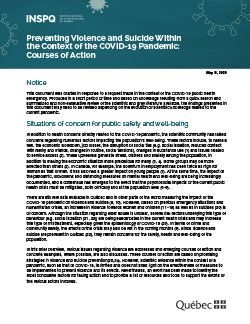Preventing Violence and Suicide Within the Context of the COVID-19 Pandemic: Courses of Action
Situations of concern for public safety and well-being
In addition to health concerns directly related to the COVID-19 pandemic, the scientific community has raised concerns regarding numerous factors impacting the population’s well-being. These factors include, to name a few, the economic slowdown, job losses, the disruption of social ties (e.g. social isolation, reduced contact with family and friends, changes in routine, social tensions), changes in substance use and issues related to service access. These upheavals generate stress, distress and anxiety among the population, in addition to making the economic situation more precarious for many. Some groups may be more affected than others. In Canada, for example, the downturn in employment has been twice as high for women as that of men. It has also had a greater impact on young people. At the same time, the impact of the pandemic, lockdowns and distancing measures on mental health and well-being are being increasingly documented, and a consensus has emerged to the effect that the psychosocial impacts of the current public health crisis must be mitigated, both clinically and at the population level.
There are still few data available in Québec and in other parts of the world measuring the impact of the COVID-19 pandemic on violence and suicide. However, based on previous emergency situations and humanitarian crises, an increase in violence towards women and children as well as in suicides is of concern. Although the situation regarding elder abuse is unclear, several risk factors underlying this type of behaviour (e.g. social isolation) are being exacerbated in the current health crisis and may increase this type of mistreatment, especially given the epidemiology of COVID-19. In terms of crime and community safety, the effects of the crisis may also be felt in the coming months. Since violence and suicide are prevalent in Québec, they remain concerns for the safety, health and well-being of the population.
In this brief overview, various issues regarding violence are addressed and emerging courses of action and concrete examples, where possible, are also discussed. These courses of action are based on promising strategies in violence and suicide prevention. However, scientific evidence within the context of a pandemic, such as that of COVID-19, is limited and does not shed light on the effectiveness of measures to be implemented to prevent violence and its effects. Nevertheless, an effort has been made to identify the most conclusive factors for taking action and to provide a list of resources and tools to support the efforts of the various actors involved.
